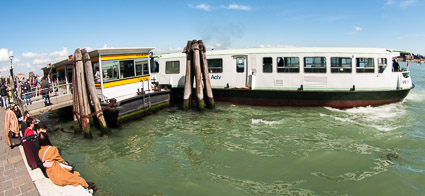Venice > Sightseeing > Islands tour
Venice Islands Tour
Plan a self-guided day trip in the Venetian
Lagoon, using public water buses.

ABOVE: Your excursion begins at the Fondamenta
Nove waterbus station, which faces the Venetian Lagoon on the northern edge of
the historic center.
By Durant
Imboden
If you're spending more
than a few days in Venice, allow time to visit the
islands of the Venetian Lagoon.
The itinerary in this article will take you to:
-
San Michele,
the walled cemetery island of Venice.
-
Murano,
known for its glassmaking, glass museum, and several historic churches.
-
Burano, an island of
fishermen, lacemakers, and colorfully painted houses.
-
Mazzorbo, a small
rural island connected to Burano by a footbridge.
-
Torcello, once a city
larger than Venice; today, a bucolic island with a 1,000-year-old
cathedral and a handful of outdoor restaurants.
-
Lido di Venezia, a
beach resort on the strip of land that separates the Venetian Lagoon
from the Adriatic Sea. (You can stop off here, if you wish, on your
return trip to
Venice.)
You'll reach the islands on
water buses operated by ACTV, the
Venice public-transportation company. Allow a full day for the entire excursion,
or half a day if you skip San Michele and the Lido.
ACTV's lagoon water buses can be crowded during peak season, on
weekends, or if local groups of senior citizens or schoolchildren are traveling
between the islands.
If crowds bother you, or if you're unwilling to stand on a
moving boat when seats aren't available, consider one of these alternatives:
-
Take an
escorted tour
of Murano, Burano, and/or Torcello. Such tours are more expensive
than a tour by public transportation, but they're worth considering if your
schedule is tighter than your budget. The trips are offered by Viator, our
sightseeing-tour partner. An even better choice is a walking tour with
Discover Burano, owned by Burano native Silvia Zanella.
-
Hire a water taxi by the half-day or day, which could easily cost several
hundred euros. If you want the services of a private guide, try a customized
lagoon itinerary from
WalksInsideVenice or the
Venice Tourist Guides Association
and let the guide arrange transportation.
Tips:
-
Organized tours don't give you much time on the islands, so we'd
recommend traveling independently unless you're in a hurry or have limited
mobility.
-
Instead of buying individual tickets for the boat trips between the
islands, buy a one- to seven-day
ACTV travel ticket at any Hellovenezia or ACTV ticket booth.
-
If you have access to the Internet during your trip, you can check boat
schedules at the official
ACTV Web site.
-
Looking for a smaller island that's even closer to Venice? Try
La Certosa, which has a marina, a hotel, and
acres of green space where kids and dogs can run free.
San Lazzaro degli Armeni, an
island monastery, is also worth a visit.
Next page:
San Michele Cemetery
About the author:
 Durant Imboden has
written about Venice, Italy since 1996.
He covered Venice and European travel at About.com for 4-1/2 years before launching
Europe for Visitors (including
Venice for Visitors) with Cheryl
Imboden in 2001. Durant Imboden has
written about Venice, Italy since 1996.
He covered Venice and European travel at About.com for 4-1/2 years before launching
Europe for Visitors (including
Venice for Visitors) with Cheryl
Imboden in 2001.
PC Magazine has called this "the premier visitors'
site for Venice, Italy." Over the years, it has helped more than 30 million
travelers. For more information, see About our site,
our Europe for Visitors
press clippings,
and
our reader testimonials.
| |
|

